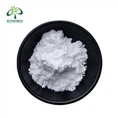Urokinase (Peptidolytic) (9ci) Description
Urokinase powder, known in the chemical and pharmaceutical circles by its more scientific name, "peptidolytic enzyme" (9CI), represents a fascinating and vital component in the medical field, especially in treating thrombolytic diseases and management aspects. This serine protease enzyme is essential to the body's fibrinolytic system. It breaks down blood clots and helps avoid potentially fatal illnesses such as sex stroke, deep vein thrombosis, and pulmonary embolism.
It is a proteolytic enzyme that targets explicitly and cleaves plasminogen (the inactive precursor of plasmin). Plasminogen circulates throughout the bloodstream and can dissolve fibrin clots when activated to form plasmin. Fibrin is the main structural component of blood clots, and its breakdown is critical to dissolving clots that are no longer needed or that pose health risks by blocking blood vessels. The action of urokinase involves binding to plasminogen to form a complex, which then undergoes a conformational change that promotes the conversion of plasminogen to plasmin. Once formed, plasmin can effectively degrade fibrin and other plasma proteins, leading to thrombolysis. This process is tightly regulated in the body to ensure that the clot does not break down too early, which could cause excessive bleeding, or too late, which could cause blood clots to form. The ability of it to dissolve blood clots makes it an essential drug in the treatment of various thrombotic diseases. It is precious in acute settings where rapid dissolution of clots can save lives, such as acute pulmonary embolism or acute myocardial infarction. In some instances of stroke, it is also used to treat peripheral artery occlusions, breaking up blood clots that impede blood flow to the brain. If you need raw urokinase, contact Xi'an Sonwu.

What Is The Action Of Urokinase
The principle of action and target of urokinase mainly involve blood coagulation and fibrinolytic systems. It is a crucial plasminogen-activating enzyme that can convert plasminogen (Plasminogen) in plasma into plasmin (Plasmin), thereby promoting thrombus dissolution. It acts directly on plasminogen in plasma, activating it into plasmin. Plasminogen is a protein that exists in an inactive form in the blood, and it activates it by cleaving specific peptide bonds in plasminogen. Activated plasmin can degrade fibrin, a key component of thrombus. Fibrin is the main protein that forms thrombus. Plasmin cleaves fibrin, causing structural destruction of the thrombus and ultimately dissolving the thrombus. Dissolving thrombus helps restore blood flow to blocked vessels and reduce or eliminate tissue ischemia caused by thrombus, which is of great significance in treating acute vascular obstructive diseases such as myocardial infarction and pulmonary embolism.
The direct target of it is plasminogen, which acts by binding to plasminogen and activating it to plasmin. Plasmin further acts on fibrin and is an indirect target of it. This chain reaction is not limited to dissolving the formed thrombus but also regulates blood coagulation and anticoagulation balance to maintain blood vessel health.

What Are The Benefits Of Urokinase
1. Effectively dissolve blood clots
Urokinase directly helps dissolve blood clots, restoring normal blood flow to the affected area. That is critical in conditions such as pulmonary embolism, acute myocardial infarction (heart attack), and certain types of stroke, where rapid restoration of blood flow can prevent severe damage to tissues and organs.
2. Reduce the risk of complications
Effectively dissolving blood clots helps reduce the risk of potential complications from thrombotic events. For example, in the case of a heart attack or stroke, timely administration of it could minimize the extent of heart muscle damage or brain damage, respectively.
3. Minimally invasive treatment
Urokinase provides a non-surgical option for the treatment of thrombotic disorders. Unlike mechanical thrombectomy or surgery, which may require the removal of clots, it can be given intravenously. This less intrusive method enables quicker deployment in an emergency and lowers the dangers connected with surgery.
4. Wide range of applications
Its uses are not limited to treating life-threatening conditions such as heart disease or stroke; it is also used to treat other conditions involving blood clots, including deep vein thrombosis and certain peripheral artery diseases. Its versatility makes it a valuable tool in the fight against various thrombotic disorders.
5. Benefits for certain non-thrombotic diseases
Studies have explored using it in non-thrombotic conditions, such as pleural effusion (excess fluid between the pleural layers outside the lungs) and certain eye conditions, where its thrombolytic mechanism may be beneficial.
6. Improve patient outcomes
For many patients, its administration can improve outcomes by rapidly resolving the immediate threat of thrombosis, thereby reducing the likelihood of long-term damage and improving quality of life after treatment.

Is Urokinase Safe
The most common clinical adverse reaction of this product is bleeding tendency.
Minor bleeding: The most common side effect is minor bleeding at the site of application, which is usually not serious. Followed by intra-tissue bleeding, the incidence rate is 5%-11%, mostly mild, and severe cases can cause cerebral hemorrhage.
Severe bleeding: Because urokinase works by promoting the dissolution of fibrin protein, this may lead to bleeding elsewhere in the body, including severe internal bleeding. The most serious cases may include intracranial hemorrhage, which is an emergency medical condition that requires immediate attention.
allergic reaction
Although less common, individual patients may develop an allergic reaction to it or its co-components. Symptoms of these reactions may include:
Difficulty breathing
Itching and skin rash
Swelling in the neck, tongue, lips, or face
Severe allergic reaction (anaphylactic shock)
Other possible side effects
Fever and chills: Some patients may experience fever and chills.
Nausea and Vomiting: It may cause digestive system reactions manifesting as nausea and vomiting.
When this product is used for thrombolysis in coronary artery recanalization, atrial or ventricular arrhythmias often occur after vessel recanalization, with an incidence rate of more than 70%, and strict ECG monitoring is required.
If you want to know the "peptidolytic enzyme" (9CI) manufacturer, you can contact Xi'an Sonwu. Click the email, and then you get high-quality raw materials.
Email: sales@sonwu.com





